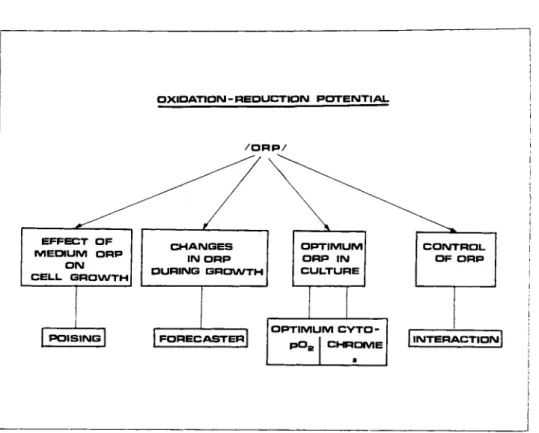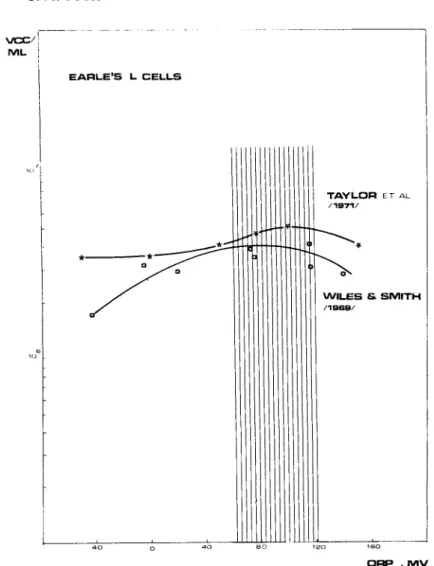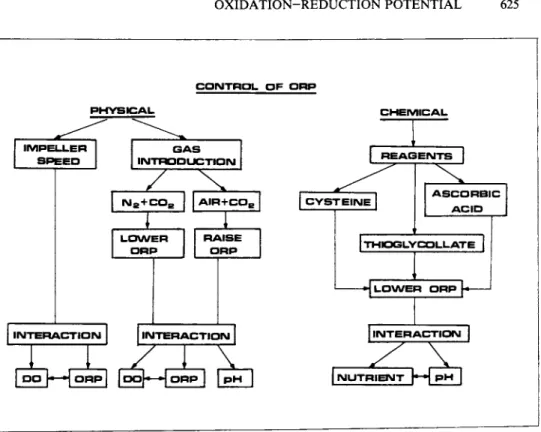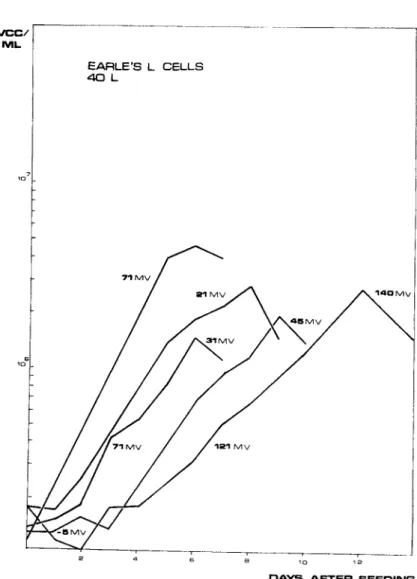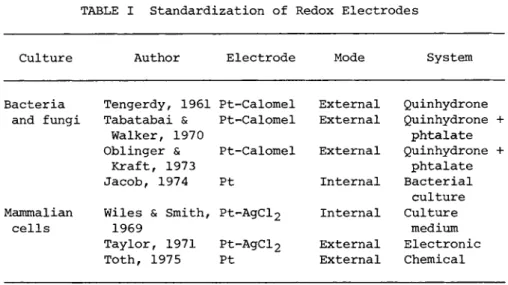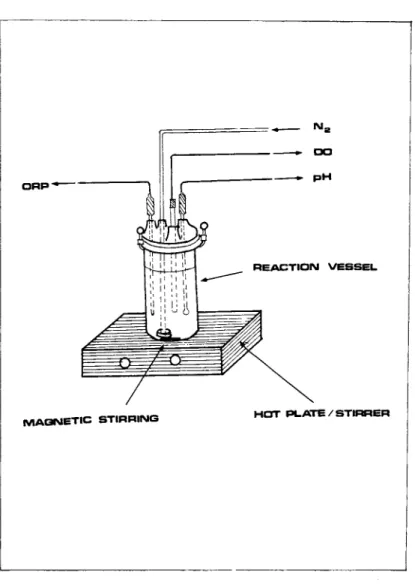SIGNIFICANCE OF OXIDATION-REDUCTION POTENTIAL IN MAMMALIAN CELL CULTURES
G. M. Toth
Fermentation Design, Inc.
Division of New Brunswick Scientific Co., Inc.
Bethlehem, Pennsylvania
I. INTRODUCTION
The role of electron distribution in animal cell membrane con- stituents and the ion dependency of electrical coupling of cells was recognized in recent years (DeRobertis et al., 1970). These seem to explain some chemical changes accompanying cellular in- teractions and cell differentiation. Also, the effect of sur- factants and chelating agents (e.g. EDTA) masking the cell mem- brane's receptor structure (Hakomori et al., 1974) indicates the importance of the molecular charge conditions on the regulation of animal cell membrane activity.
With the development of complex cell culture techniques, the question is raised: "Is there a sensor system by which changes in the culture's charge conditions can be monitored?" According to the data accumulated so far, the Oxidation-Reduction Potential
(ORP) can be used as an indicator of cellular metabolism initiated
617
618 G. M. TOTH
O X I D A T I O N - R E D U C T I O N P O T E N T I A L
/ O R P /
E F F E C T O F M E D I U M O R P
O N
C E L L G R O W T H
C H A N G E S IN O R P D U R I N G G R O W T H
O P T I M U M O R P I N C U L T U R E
C O N T R O L O F O R P
P O I S I N G F O R E C A S T E R I N T E R A C T I O N
FIGURE 1 Key points in the known role of ORP in eucaryotic cell cultures.
changes in charge conditions. This was observed both in the mi- crobial biochemistry (Hewitt, 1950; Hongo, 1958; Tengerdy, 1961;
Rabotnova, 1963) and in animal cell cultures (Cater, 1960; Loew- enstein and Kanno, 1964; Potter et al., 1960). All of the data indicated that a correlation can be established between changes in ORP and the biochemical events during the cell growth cycle.
In view of the most recent achievements in automatic control of cell culture environment (Nyiri, 1972) the utilization of a di- rect sensor of such importance is considered to be necessary for both process monitoring and control purposes.
With this need in mind, the objective of this paper is to give a brief overview of the present status of ORP in animal cell cultures.
OXIDATION-REDUCTION POTENTIAL 619 The topic is divided into several major parts (Fig. 1) which, in fact, attempt to cover our present knowledge of the role of ORP in the eucaryotic cell growth.
II. CHANGING ORP VALUES IN THE MEDIUM PRIOR TO INOCULATION
It was observed by Daniels and his coworkers (1970a; 1970b) that the ORP of sterile culture medium undergoes drastic changes if it is left unattended during an incubation period at 37°C (Fig.
2). The initial ORP value of a double strength Eagle's essential medium falls to -230mV from -lOOmV then rises again to about +75- +100mV in three days. This latter ORP level seems to be the op- timum to start growing Earle1s L cells.
Wiles and Smith (1969) introduced 95% N2 + 5% C 02 mixture to lower the ORP to -320mV then switched to 95% air + 5% C 02 to reach +75 - lOOmV. This method was adapted by us for the treatment of RPMI 1640 medium in a 600 ml flask (Fig. 3) between the ORP val- ues of +150 and -20mV. Technically speaking, this latter method has advantages in reduction of medium treating time which is of importance in large scale systems.
The effects of introducing N2 or C 02 containing air on the ORP value suggests that some p 02 related charge condition changes take place in the medium constituents during the treatment. The same effect can be achieved by processing the medium under nitro- gen to prevent the oxidation of some of its components (Mohberg and Johnson 1963).
The treatment is called poising. The advantages of this operation are in higher initial ORP levels, higher viable cell counts and longer growth periods.
620
622
OXIDATION-REDUCTION POTENTIAL 623
III. CHANGES IN ORP DURING GROWTH CYCLE
In Fig. 4 a typical growth curve is shown for Earle's L cells (Wiles and Smith, 1969) with corresponding ORP changes during culture.
In this experiment both the ORP and the cell count behave as forecasters for the sequence of events during the culture (Nyiri et al., 1976). In the first 70 hours the ORP is around +100mV and the cell count indicates a lag in growth. In the 60th hour the increase in cell number forecasts a fall in the ORP level
(Fig. 4, section 1) which will drop to a minimum of +15mV during the logarithmic state of growth. From this point on the subse- quent increase in the ORP level (Fig. 4, section 2) forecasts the peak in cell count which follows the ORP minimum within 44 hours.
IV. OPTIMUM ORP IN ANIMAL CELL CULTURE
The observations discussed above indicate the significance of ORP both as an environmental factor and as a means for process control implementation. Both of them require the determination of optimum ORP levels in cell cultures.
The optimum ORP level for Earle1s L cells is about +75mV (or +290mV against H2 electrode) and was established independently by two research groups (Wiles and Smith, 1969; Taylor et al., 1971)
(Fig. 5). This potential is the same as the standard potential for cytochrome oxidase. The control of the ORP at or near this potential value probably keeps the cell cytochrome oxidase in the optimum condition to carry out tetravalent reduction of oxygen to water.
On the other hand Taylor and his co-workers pointed out (1971) that +75mV ORP value corresponds to about lOOmmHg p 02. This oxygen tension exists in the in vivo growing tissues.
624 G. M.TOTH
vcc /J
M L j
I E A R L E ' S L C E L L S
O R P , M V
FIGURE 5 Optimum ORP levels for growing Earle's L cells.
V. CONTROL OF ORP
The information concerning the changes in pH, ORP and DO pat- terns during a cell culture give the key to control of ORP in mammalian cell cultures.
OXIDATION-REDUCTION POTENTIAL 625
C O N T R O L O F P H P
P H Y S I C A L C H E M I C A L
I M P E L L E R S P E E D
G A S
I N T R O D U C T I O N R E A G E N T S
Na+ C Os
L O W E R
I N T E R A C T I O N
A I R + C OE
zzz
C Y S T E I N ER A I S E O R P
I N T E R A C T I O N
O R P p H
A S C O R B I C A C I D
T H t O G L Y C O L L A T E
^
L O W E R O R P l l N T E R A C T I O N IN U T R I E N T p - H P H
FIGURE 6 Control of ORP in eucaryotic cell cultures.
There are different approaches reported so far (Fig. 6 ) : the control can be implemented either physically by changing the im- peller speed and/or sparging with gases (N2, C 02, Air) (Daniels and Browning, 1962; Daniels et al., 1965) or chemically by adding cysteine, ascorbic acid, sodium thioglycollate or a mixture of cysteine and ascorbic acid (Daniels et al., 1965). The time of response on the ORP level is different in each case. The fastest response was obtained in the case of chemically influencing the ORP (2 minutes) and the slowest was in the case of changing the impeller speed with fixed air/gas flow rate (1^ hour).
The control of ORP through changing agitation speed and gas introduction reflects the relationship between ORP and p 02 as well as emphasises the necessity of proper control of dissolved oxygen
626 G. M. TOTH
v c c /
M L
EARLE'S L CELLS 40 L
D A Y S A F T E R S E E D I N G
FIGURE 7 Growth curves for Earle's L cells influenced by different ORP levels during culture.
concentration as expressed in the following oxygen balance equation:
-Q02 X = KLa (C* - C) /!/
The value of KLa can be improved by increasing the impeller speed (Aiba et al., 1973).
OXIDATION-REDUCTION POTENTIAL 627 The control of ORP can also be carried out by introducing a
standard mixture of different gases as the culture conditions re- quire the lowering or raising of the ORP level. The gas mixture can comprise N2, C 02 and/or air as specified earlier. The nature of this control is strictly interactive. Since the introduction of N2 lowers p 02 and pC02 (so influencing ORP and pH) it is sug- gested to apply a N2/ C 02 mixture instead of pure N2. However, because of the difference in the solubility of C 02 and 02 in the culture liquid, the ratio of the N2 to C 02 must be defined by the changes in the pH which is in turn, defined by pC02.
The control of ORP level in the culture by adding chemical compounds to it is applied the least because of the inconvenience of steril addition of the compounds and because of their extensive effect on the pH and ORP levels.
The advantage of controlling ORP in mammalian cell cultures was demonstrated by Wiles and Smith (1969). If the optimal ORP level - which is about +75mV - was maintained throughout the run, the peak cell count and the generation time were at their maximum (Fig. 7 ) . If, however, the ORP was changed significantly during the run, the maximum count was significantly reduced.
VI. STANDARDIZATION OF ORP ELECTRODES
The key problem in the proper control of redox potential is the reliability of the ORP sensor system.
There has been different approaches in attempting to stan- dardize redox electrodes both in bacterial and in mammalian cell cultures. These experiments were either external or internal procedures according to the nature of the standardization, e.g.
using the culture itself or taking a sample. Biological cultures are very weakly poised in the sense that very little redox agent is needed to cause very large ORP changes. This makes sampling the culture for purposes of checking externally the ORP difficult.
628 G. M. TOTH
TABLE I Standardization of Redox Electrodes
Culture Author Electrode Mode System
Bacteria Tengerdy, 1961 Pt-Calomel External Quinhydrone and fungi Tabatabai & Pt-Calomel External Quinhydrone +
Walker, 1970 phtalate
Oblinger & Pt-Calomel External Quinhydrone +
Kraft, 1973 phtalate
Jacob, 1974 Pt Internal Bacterial culture Mammalian Wiles & Smith, Pt-AgCl2 Internal Culture
cells 1969 Pt-AgCl2
medium Taylor, 1971 Pt-AgCl2 External Electronic Toth, 1975 Pt External Chemical
because in transferring the sample to an external measuring sys- tem, the absorption of small amounts of air causes the ORP to in- crease sufficiently to make the result meaningless. Therefore, the ORP system can not be standardized the same way with an ex- ternal standard as is done with the pH of the culture liquid.
Table I compiles the standardization techniques for ORP sen- sors applied in bacterial and mammalian cell cultures.
Concerning the latter one. Wiles and Smith (1969) and Toth1s (1975) method will be discussed.
Wiles and Smith (1969) used the medium itself to standardize redox electrodes from batch to batch. The principle of their measurement is that the medium contains a significant amount of redox groups that have equivalence points in the range of ORP1 s encountered in poising. These points can be used as internal standards to check the accuracy of the ORP electrodes.
They developed the method empirically for a Beckman Pt and L
& Ν Ag-AgCl reference electrode by comparing poising data from several runs. Freshly mixed Eagle's MEM normally had a negative ORP between -80 - lOOmV. The low point for their medium composi- tion was -322mV.
OXIDATION-REDUCTION POTENTIAL 629 The method consists of stripping the medium of all oxygen by sparging with 95% N2 + 5% C 02 until a minimum ORP was constant for at least 1/2 hour and then by raising the ORP to the desired level by sparging with 95% air + 5 % C 02. They obtained a curve similar to the Potentiometrie titration curves with two break points. The ORP electrode system was calibrated by using a mean value for the break point as an internal standard. The method for locating the break point was developed empirically. With successive runs for the double-strength Eagle's minimum essential medium they found -79 + 20mV for the break point with a 99% con- fidence level.
It has to be emphasized that the values of the characteristic break points are valid only for the particular medium composition.
For other media the poising behavior must be studied to determine its characteristics before trying to apply this technique. On the other hand this method does not establish a reference point for the electrode by which the validity of readings can be checked.
The method developed by Toth (1975) for a steam sterilizable Ingold Platinum combined redox electrode is an external procedure using chemical means for establishing a standard ORP value for electrode calibration.
The basic principle of the method is to use systems where the redox potential is dependent only upon the concentration of the reduced form of certain compounds so by changing the absolute amount of the substance, the electrode potential will change proportionally (Hewitt 1950). Such a system is the cystine- cysteine, where the potential depends only upon the concentration of cysteine (RSH) and the hydrogen ions and not upon the concen- tration of the oxidized form, cystine (RSSR):
2 RSH • RSSR + H2 The reaction is irreversible.
630 G. M. TOTH
VII. APPARATUS FOR CALIBRATION OF ORP ELECTRODES
The apparatus used for the calibration is a 600 ml reaction vessel with an airtight removable top secured with a cover clamp
(Thomas Co., Philadelphia, Pa) (Fig. 8). The top has four immer- sion holes which provide for pH, DO and redox probes and the N2 sparging line. These variables are monitored and recorded during the measurement. The vessel stands on a hot plate - magnetic stirrer which allows the temperature control and constant agita- tion of the solution.
Before starting the probe's calibration, a known electromotive force is impressed on the input of the redox meter making the re- dox measurements in a range of -lOOOmV to +1000mV possible.
The procedure starts with the making of a 600 ml phosphate buffer mixture in the reaction vessel. Before installing the re- dox Pt electrode the surface of it is cleaned with Ce02. After the installation of all the electrodes and adjustment of the tem- perature the pH of this solution should set to 7.0. At this time the deoxygenation of the solution commences by passing N2 through it at a rate of 2000 ml/min so deoxygenation is achieved in 40 minutes. At this point the ORP value read on the meter is zero and serves to check out the measuring system and the amplifier.
The compounds used for chemical calibration are cysteine .H CI and glutathione in the concentration range of 0.2-1.4xl0~3 Mole. The corresponding amounts of the compounds are measured out and added to the reaction vessel while maintaining the para- meters of pH = 7.0, DO = 0, Ô = 3.0°. The obtained relationship between reagent concentration and redox readings is shown in Fig. 9.
After the amplifier and the Pt electrode has been checked out and calibrated, the Pt electrode is removed, its surface is cleaned again by the same procedure mentioned earlier and it can be installed on the culture vessel.
OXIDATION-REDUCTION POTENTIAL
FIGURE 8 Apparatus for external calibration of steam sterilizable Pt redox electrodes.
632
OXIDATION-REDUCTION POTENTIAL 633
VIII. CONCLUSIONS
The significance of oxidation-reduction potential in animal cell cultures was recognized in the early thirties and was veri- fied in vitro studies almost a decade ago.
Recently the effect of poising of culture medium, the optimum ORP as well as its control is well documented. These facts indi- cate the ORP1s correlation with charge condition changes during the mammalian cell's life cycle.
The most recent discoveries with regard to the changes within the cell-environment and cell-cell interactions as well as the changes in the cell membrane structure during differentiation and malignant transformation amplify the importance of studies re-
lated to charge conditions in animal cell cultures.
Although a direct sensor (redox electrode) is available to implement such studies the literature indicates few efforts in this area. With the development of proper calibration methods of redox electrodes and with their extended application in mammalian cell cultures it is anticipated that correlation studies will be conducted revealing the role of ORP in the cells1 life cycle.
Such studies ultimately will lead to improved environmental con- trol of the in vitro cultures which is the prerequisite of the proliferation of mammalian cells.
NOTATIONS
C* Concentration of dissolved oxygen which is in equilibrium with partial pressure (p02) in bulk gas phase (g mole/cm3).
C Actual concentration of dissolved oxygen in bulk liquid (g mole/cm3).
KLa Oxygen mass transfer coefficient in aqueous phase (1/hr).
Q 02 Specific rate of oxygen uptake by an animal cell in suspen- sion culture at C (g mole/cell/hr).
X Number of viable cells in suspension (cells/m3).
634 G. M. TOTH
REFERENCES
1. Aiba, S.t Humphrey, Á. Å., Millis, N. F., (1973), in "Bio- chemical Engineering," Second Ed., pp. 179-181, University of Tokyo Press.
2. Balakireva, L. M., Kantere, V. M., Rabotnova, I. L., (1974), Biotechnol. Bioeng. Symp. 4, 769-780.
3. Cater, D. B., (1960), Proc. in Biophys. and Biophys. Chem.
10, 154-193.
4. Daniels, W. F., Browning, E. W., (1962), Biotechnol. Bioeng.
4, 79-86.
5. Daniels, W. F., Parker, D. Á., Johnson, R. W., (1965), Biotechnol. Bioeng. 7, 529-553.
6. Daniels, W. F., Garcia, L. H., Rosensteel, J. F., (1970a), Biotechnol. Bioeng. 12, 409-417.
7. Daniels, W. F., Garcia, L. H., Rosensteel, J. F., (1970b), Biotechnol. Bioeng. 12, 419-428.
8. DeRobertis, E. D. P., Nowinski, W. W., Saez, F. Á., (1970), in "Cell Biology," Fifth Edition, pp. 429-432, W. B.
Saunders Co.
9. Garcia, L. H., Daniels, W. F., Rosensteel, J. F., (1967), Biotechnol. Bioeng. 9, 626-629.
10. Hakomori, S., Gahmberg, C. G., Laine, R., Kijimoto, S., (1974), Cold Spring Harbor Conference on Cell Prolif. 1, 461-471, Cold Spring Harbor Laboratory.
11. Hewitt, L. F., (1950) in "Oxidation-Reduction Potentials in Bacteriology and Biochemistry," Sixth Ed., pp. 45-48, E. &
5. Livingstone Ltd., Edinburgh.
12. Hongo, Ì., (1958), Nippon Nogeikagaku Kaishi, 32¢, 101-113.
13. Jacob, H. E., (1974), Biotechnol. Bioeng. Symp. No. 4, 781- 788.
14. Loewenstein, W. R., Kanno, Õ., (1964), J. Cell. Biol. 22, 565-570.
OXIDATION-REDUCTION POTENTIAL 635 15. Mohberg, J., Johnson, Ì· J., (1963), J. Nat. Cancer Inst.
31(3), 603-610.
16. Nyiri, L. Ê., (1972), in "Advances in Biochemical Engineer- ing," (Ghose, Ô. Ê., Fiechter, A. and Blakebrough, N.
eds.), Vol. 2., pp. 49-95, Springer Verlag, Berlin.
17. Nyiri, L. Ê., Toth, G. Ì., Charles, Ì., (to be published) Biotechnol. Bioeng. 18.
18. Oblinger, F. L., Kraft, Á. Á., (1973), J. Food Science, 38, 1108-1112.
19. Potter, D. D,, Furshpan, E. J., Lennox, E. S., (1966), Proc.
Nat. Acad. Sei. U.S.A., 55, 328-332.
20. Rabotnova, I. L., (1963), in "Die Bedeutung physikalisch- chemischer Factoren (pH and rH2) für die Lebenstatigkeit der Mikroorganismen," VEB Gustav Fischer Verlag, Jena.
21. Tabatabai, L. Â., Walker, Ç. W., (1970), Appl. Microbiol.
20(3), 441-446.
22. Taylor, G. W., Kondig, J. P., Nagle, S. C., Jr., Higuchi, Ê., (1971), Appl. Microbiol. 21(5), 928-933.
23. Tengerdy, R. P., (1961), J. Biochem. Microbiol. Tech. Eng.
3(3), 241-253.
24. Toth, G. M., (1975), unpublished communication.
25. Wiles, C. C., Smith, V., (1969), Amer. Inst. Chem. Eng.
Symp. Bioeng. Techno1. November, 85-93.
